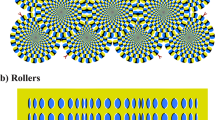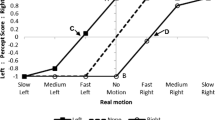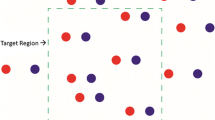Abstract
The position of a drifting sine-wave grating enveloped by a stationary Gaussian is misperceived in the direction of motion. Previous research indicated that the illusion was larger when observers pointed to the center of the stimulus than when they indicated the stimulus position on a ruler. This conclusion was reexamined. Observers pointed to the position of a small Gabor patch on the screen or compared its position to moving patches, stationary lines, or flashed lines. With moving patches, the illusion was larger with probe than with motor judgments; with stationary lines, the illusion was about the same size; and with flashed lines, the illusion was smaller with probe than with motor judgments. Thus, the comparison between perceptual and motor measures depended strongly on the methods used. Further, the target was mislocalized toward the fovea with motor judgments, whereas the target was displaced away from the fovea relative to line probes.




Similar content being viewed by others
References
Aglioti S, DeSouza JF, Goodale MA (1995) Size-contrast illusions deceive the eye but not the hand. Curr Biol 5:679–685
Bischof N, Kramer E (1968) [Investigations and considerations of directional perception during voluntary saccadic eye movements]. Psychologische Forschung 32:185–218
Bock O (1986) Contribution of retinal versus extraretinal signals towards visual localization in goal-directed movements. Exp Brain Res 64:476–482
Bridgeman B (1998) Durations of stimuli displayed on video display terminals: (n-1)/f + Persistence. Psychol Sci 9:232–233
Bridgeman B (2002) Attention and visually guided behavior in distinct systems. In: Prinz W, Hommel B (eds) Common mechanisms in perception and action—attention and performance, vol. XIX. Oxford University Press, Oxford
De Valois RL, De Valois KK (1991) Vernier acuity with stationary moving Gabors. Vis Res 31:1619–1626
Franz VH (2001) Action does not resist visual illusions. Trends in Cognitive Sciences 5:457–459
Franz VH, Gegenfurtner KR, Bülthoff HH, Fahle M (2000) Grasping visual illusions: no evidence for a dissociation between perception and action. Psychol Sci 11:20–25
Goodale MA, Milner AD (1992) Separate visual pathways for perception and action. Trends Neurosci 15:20–25
Henriques DY, Klier EM, Smith MA, Lowy D, Crawford JD (1998) Gaze-centered remapping of remembered visual space in an open-loop pointing task. J Neurosci 18:1583–1594
Hubbard TL (1995) Environmental invariants in the representation of motion: implied dynamics and representational momentum, gravity, friction, and centripetal force. Psychon Bull Rev 2:322–338
Kerzel D (2002) Memory for the position of stationary objects: disentangling foveal bias and memory averaging. Vis Res 42:159–167
Kerzel D (2003) Mental extrapolation of target position is strongest with weak motion signals and motor responses. Vis Res 43:2623–2635
Kerzel D, Gegenfurtner KR (2003) Neuronal processing delays are compensated in the sensorimotor branch of the visual system. Curr Biol 13:1975–1978
Lemij HG, Collewijn H (1989) Differences in accuracy of human saccades between stationary and jumping targets. Vis Res 29:1737–1748
Milner D, Dyde R (2003) Why do some perceptual illusions affect visually guided action, when others don’t? Trends in Cognitive Sciences 7:10–11
Müsseler J, Stork S, Kerzel D (2002) Comparing mislocalizations with moving stimuli. The Fröhlich effect, the flash-lag effect and representational momentum. Vis Cogn 9:120–138
Neggers SF, Bekkering H (2000) Ocular gaze is anchored to the target of an ongoing pointing movement. J Neurophysiol 83:639–651
Nijhawan R (1994) Motion extrapolation in catching. Nature 370:256–257
Nijhawan R (2002) Neural delays, visual motion and the flash-lag effect. Trends in Cognitive Sciences 6:387
Ramachandran VS, Anstis SM (1990) Illusory displacement of equiluminous kinetic edges. Perception 19:611–616
Sheth BR, Shimojo S (2001) Compression of space in visual memory. Vis Res 41:329–341
Sheth BR, Shimojo S (2003) Signal strength determines the nature of the relationship between perception and working memory. J Cogn Neurosci 15:173–184
Sparks DL (2002) The brainstem control of saccadic eye movements. Nature Review Neuroscience 3:952–964
Whitney D, Goltz HC, Thomas CG, Gati JS, Menon RS, Goodale MA (2003) Flexible retinotopy: motion-dependent position coding in the visual cortex. Science 302:878–881
Yamagishi N, Anderson SJ, Ashida H (2001) Evidence for dissociation between the perceptual and visuomotor systems in humans. Proc R Soc Lond B Biol Sci 268:973–977
Acknowledgements
The author was supported by the Deutsche Forschungsgemeinschaft (DFG KE 825/3-1 and 825/4-1,2). We wish to thank Nina Barthel, Jana Buchmann, Julia Verena Hardt, and Fereshteh Zahir-Fard for helping with data collection.
Author information
Authors and Affiliations
Corresponding author
Rights and permissions
About this article
Cite this article
Kerzel, D., Gegenfurtner, K.R. Motion-induced illusory displacement reexamined: differences between perception and action?. Exp Brain Res 162, 191–201 (2005). https://doi.org/10.1007/s00221-004-2139-z
Received:
Accepted:
Published:
Issue Date:
DOI: https://doi.org/10.1007/s00221-004-2139-z




